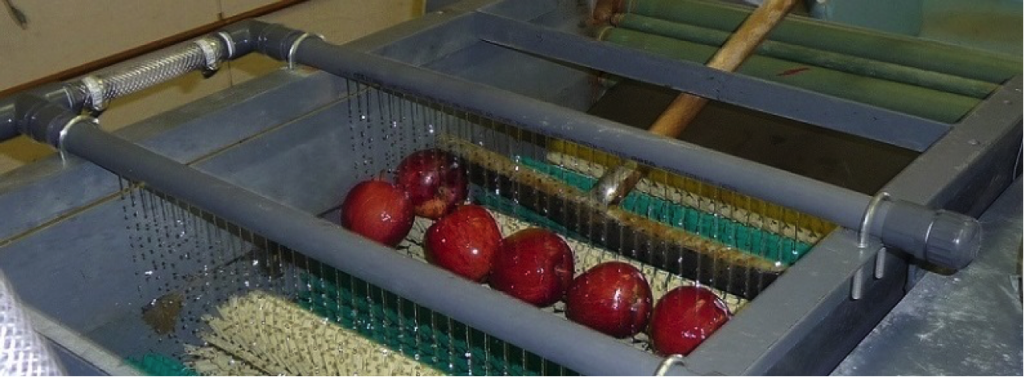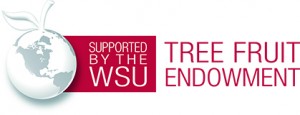Microbial Safety
 The Food Safety and Modernization Act (FSMA) was passed in January of 2011 with the goal of protecting public health by ensuring that the U.S. food supply is safe from microbial contamination. Fresh fruit do not have a cooking or processing step that would otherwise kill bacteria, so extra caution is required along the food chain to ensure food safety. Food safety issues are an important consideration for all growers and shippers of fresh fruit. Fresh produce buyers require food safety and quality procedures, but the specifics may vary among buyers, states, and countries. For this reason it is recommended that tree fruit growers and handlers follow a food safety and traceability program from “farm to table” at all times regardless of their buyers’ requirements.
The Food Safety and Modernization Act (FSMA) was passed in January of 2011 with the goal of protecting public health by ensuring that the U.S. food supply is safe from microbial contamination. Fresh fruit do not have a cooking or processing step that would otherwise kill bacteria, so extra caution is required along the food chain to ensure food safety. Food safety issues are an important consideration for all growers and shippers of fresh fruit. Fresh produce buyers require food safety and quality procedures, but the specifics may vary among buyers, states, and countries. For this reason it is recommended that tree fruit growers and handlers follow a food safety and traceability program from “farm to table” at all times regardless of their buyers’ requirements.
The new FSMA regulations require farms of certain sizes and incomes, to trace food from the farm to the retail stores, and document safety procedures during every step of production to safe guard against food borne illness. Hazard Analysis and Critical Control Points (HACCP) is a management system that analyzes each point in the process of food production for potential hazards and corrects them. Information about HACCP training can be found here.
To assist the industry with setting up a traceability program the Washington State Department of Agriculture, in conjunction with the US Department of Agriculture, provides Washington growers and shippers a voluntary auditing service to verify that best practices are being followed using the USDA’s Good Agricultural Practices/Good Handling Practices (GAP/GHP) audit program.
Information on the difference between FSMA, GAPs, and 3rd Party certifications can be found here, and a factsheet about FSMA can be found here. The FDA produce safety standards are documented here.
FDA is in the process of developing a proposed rule that will establish science-based minimum standards for the safe production and harvesting of fruits and vegetables and will address soil amendments, worker health and hygiene, packaging, temperature controls, water, and other issues. Changes to the current rule would effect regulations involving the use of animal based soil amendments such as manure composts, how surface water for irrigation is sampled, how a farm is defined and even how farm sales are calculated for FSMA compliance. Information about the proposed changes can be found here.
Chemical Residues
Another food safety issue includes the Maximum Residue Levels (MRL’s) of chemicals on produce in parts per million permitted by individual countries. You can see the MRL’s by country for apples, pears and cherries here. The list of chemicals and country-specific MRLs continually change, so this is a concern to Pacific Northwest fruit exporters. The WSU Decision Aid System includes current information regarding MRLs in conjunction with the orchard pest spray recommendations. You can also search on the official Codex MRL database webpage or visit the USDA Foreign Agricultural Service’s website with a searchable MRL database. Chemical usage at the packing house including fungicidal treatments, anti-scald drenches and fruit wax ingredients are also subject to MRL limitations.
Since 2011 researches at the WA Tree Fruit Research Commission (WTFRC) have performed studies on apples and cherries to develop basic residue data for commonly used insecticides, acaricides and fungicides to help Washington growers make more informed choices for their orchard spray programs. The 2016 study results on apples have been released and can be viewed here. Previous study results can be found on the WTFRC website.
Resources
- Bridging the GAPs: Farm Guide, a new publication from WSDA that is considered the “go-to guide” for on-farm food safety. (Accessed: 1/19/17).
- Handbook for Small and Direct Marketing Farms: Regulations and Strategies for Farm Businesses in WA State, WSDA has released this updated 7th edition publication referred to as “the Greenbook.” (Accessed: 1/19/17).
- Breaking: FSMA Preventive Controls rule now final, Fruit Growers News, September, 2015.
- Beating the odds, G. Warner, Good Fruit Grower, January, 2015.
- UV light controls pathogens, G. Warner, Good Fruit Grower, November, 2015.
- Reducing food safety risks at every opportunity, M. Hansen, Good Fruit Grower, April, 2014.
- EPA asked to halt pesticide use on apples until new safety studies are done, C. Siegner, Food Safety News, April, 2014.
- Food safety committee guides research, M. Hansen, Good Fruit Grower, March, 2013.
- Food safety mistakes, M. Hansen, Good Fruit Grower, May, 2013.
- Ultraviolet-C light inactivation of Escherichia coli O157:H7 and Listeria monocytogenes on organic fruit surfaces, A. Adhikari, et al., International Journal of Food Microbiology, 210:136-142, October, 2015.
